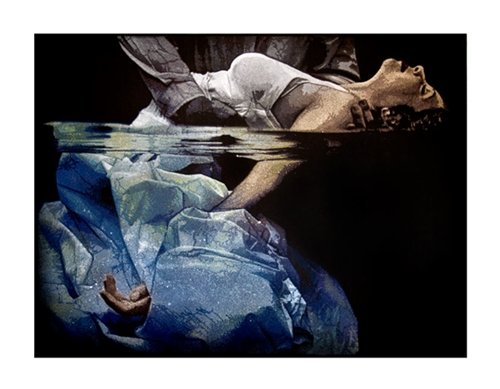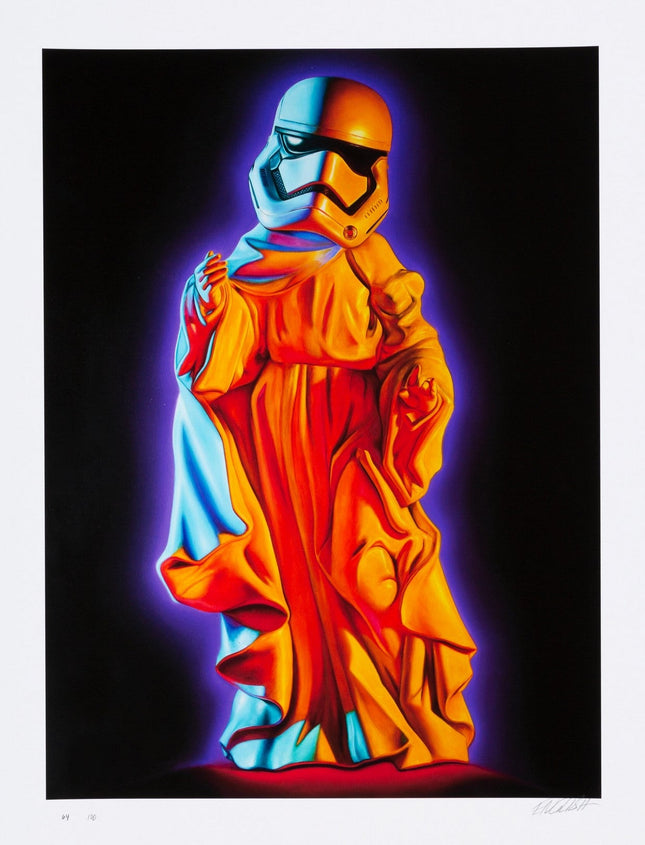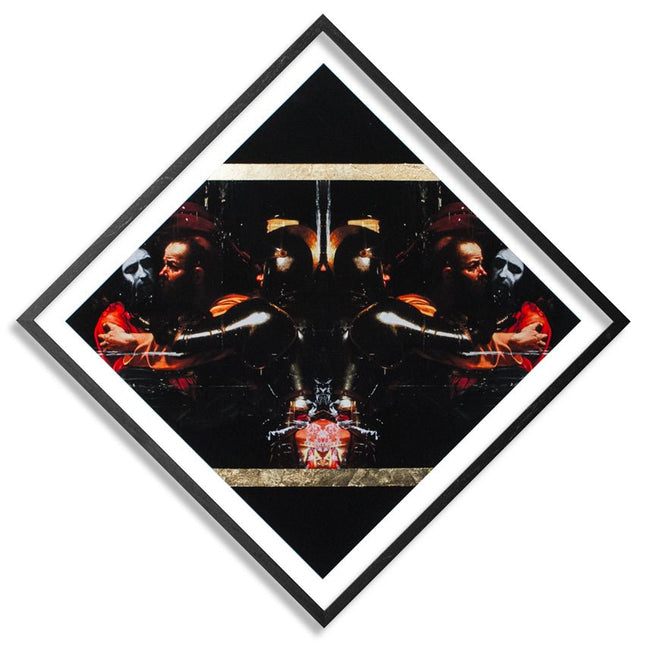
Religion
-

Logan Hicks Deep Sleep Giclee Print by Logan Hicks
Deep Sleep Artwork Giclee Limited Edition Print on Fine Art Rag Paper by Pop Culture Graffiti Artist Logan Hicks. 28 x 22 inch Archival Pigment print on 310 gsm Fine art paper All prints are signed and numbered Edition of 40 + 4 AP's Logan Hicks is an American stencil artist, currently living and working in Los Angeles, California. His hand-cut stencil process involves cutting a separate stencil for each color, then layering each color upon the next until the final piece emerges, often hundreds of hours later, as a hyper-realistic masterpiece. Originally a screen printer, Logan sold off his equipment to finance his migration from the East Coast to the West Coast, turning to stenciling to re-invigorate his printing.
$352.00
-

Ron English- POPaganda Stormtrooper Messiah Archival Print by Ron English- POPaganda
Stormtrooper Messiah Limited Edition Archival Pigment Fine Art Prints on Moab Entrada Fine Art Paper by Graffiti Street Art and Pop Culture Artist Ron English- POPaganda. 2021 Signed & Numbered Limited Edition of 100 Archival Pigment Print in Colors on Moab Entrada Fine Art Paper Artwork Size 17x22 The "Stormtrooper Messiah" is a limited edition work of art by the critically acclaimed artist Ron English- POPaganda, known for his provocative blend of street art and pop culture iconography. This particular piece is one of a series of 100 archival pigment prints, each signed and numbered to assure its collectability and authenticity. The artwork measures 17x22 inches and is rendered on Moab Entrada Fine Art Paper, a choice that denotes high quality and ensures the longevity and vibrancy of the colors used in the print. This piece by English is a powerful commentary on the intersections of ideology, iconography, and the indoctrination mechanisms within our society. It reimagines a standard stormtrooper - a symbol of the faceless enforcer from the "Star Wars" franchise - in the garb of a religious icon, precisely resembling the Messiah. This fusion of imagery from distant corners of culture spotlights the often unexamined devotion we have to certain facets of pop culture, paralleling religious fervor. English’s choice of a stormtrooper, an emblem of collective identity and unyielding authority, enveloped in the trappings of a spiritual figure, questions the role of such figures and the institutions behind them in shaping beliefs and behaviors. The artist employs luminous and contrasting colors to breathe a sense of reverence into the figure, an approach that reflects the aura often associated with religious artworks. The flowing robes in vivid hues give the subject a sense of motion and ethereal presence, intensifying the impact of the visual juxtaposition. The "Stormtrooper Messiah" is more than a piece of fine art; it's a visual discourse that challenges the viewers to reflect on the narratives and symbols that influence their understanding of power, culture, and spirituality. Ron English- POPaganda, through his distinctive merger of street art's grit and pop art's fascination with the mainstream, has created an arresting image that continues to spark conversations in the art community and beyond.
$360.00
-

Jason Seife 011|110- 22 x 22 Archival Print by Jason Seife
011|110- 22 x 22 Limited Edition Hand-Embellished HPM Archival Pigment Prints on 310gsm Fine Art Paper by Jason Seife Graffiti Street Artist Modern Pop Art. 2016 Signed & Numebred Limited Edition of 15 Artwork Size 22x22 "The overall theme of this series was overcoming obstacles and tough times to reach a greater goal, this piece, in particular, referencing the betrayal of Jesus by Judas, which to some may seem like a direct religious or biblical reference, but it, in fact, can be related to our everyday life in the feeling of betrayal which is something we have to deal with from friends, coworkers and sometimes even family/loved ones. It's a very tough thing to get over, and something I wanted to transcend into my painting. This piece, like a lot of my work, was inspired by a renaissance painting. In this case, it was a Caravaggio piece. Coming from a background in graphic design and just design in general, aesthetically I like playing off of symmetry and geometric shapes which bring a more modern take on the renaissance style. Presenting styles in a way our eyes aren't accustomed to viewing them is something that intrigues me." - Jason 011|110 – Limited Edition Hand-Embellished HPM Archival Pigment Print by Jason Seife 011|110 is a striking 22 x 22-inch limited edition hand-embellished HPM archival pigment print by Jason Seife, created in 2016. This piece, part of a highly exclusive edition of 15, is printed on 310gsm fine art paper and signed and numbered by the artist. The composition blends elements of classical Renaissance aesthetics with modern digital symmetry and geometric abstraction, reflecting Seife’s deep interest in reinterpreting historical art through contemporary techniques. The work draws direct inspiration from the dramatic lighting and emotional intensity of Caravaggio’s paintings, bringing an old-world sense of depth and realism into the context of Street Pop Art and Graffiti Artwork. The artwork features a mirrored composition, emphasizing duality and reflection, both literally and metaphorically. At its core, the piece references the biblical betrayal of Jesus by Judas, a moment charged with themes of loyalty, deception, and consequence. However, Seife’s intent is not purely religious but rather a universal exploration of personal betrayal. The emotions depicted—distrust, confrontation, and reckoning—are relevant in everyday life, whether in friendships, professional environments, or family relationships. The symmetry in the design, combined with the use of bold contrast and fine embellishments, makes this work a powerful visual statement on struggle and perseverance. Jason Seife and His Influence on Street Pop Art and Graffiti Artwork Jason Seife is a contemporary artist known for his intricate fusion of classical techniques with modern digital aesthetics. Raised in Miami, he was heavily influenced by both the vibrant graffiti culture of the city and the refined traditions of fine art. His work often explores themes of cultural identity, historical reinterpretation, and the juxtaposition of traditional craftsmanship with contemporary technology. Seife’s approach to art is deeply rooted in balance—blending ornamental flourishes with modern abstraction, historical references with futuristic compositions. His exploration of geometric symmetry within 011|110 highlights his background in graphic design, creating a structured yet deeply emotive visual experience. By borrowing from Renaissance-era compositions and integrating them into a distinctly modern framework, Seife challenges how art is traditionally perceived and invites viewers to see historical narratives through a new lens. The Role of Archival Pigment Prints in Modern Urban Art The use of archival pigment printing in Street Pop Art and Graffiti Artwork has transformed the way artists present and distribute their work. Unlike traditional screen printing, pigment-based fine art prints allow for an extraordinary level of detail, ensuring that each nuance of the original painting is preserved. The 310gsm fine art paper used in 011|110 enhances the depth and contrast of the colors, creating a piece that maintains the integrity of the artist’s vision while being durable and collectible. Hand-embellished prints add an additional layer of uniqueness, as each edition contains personal touches that differentiate it from the others in the series. This process blends the exclusivity of an original painting with the accessibility of a print edition, making high-quality art available to collectors while maintaining the tactile, human element of the artist’s hand. Seife’s attention to the printing process ensures that each piece in this edition retains the same level of craftsmanship and visual impact as the original. Collectibility and Cultural Significance of 011|110 011|110 stands as a testament to Jason Seife’s ability to merge historical influences with contemporary aesthetics, making it a highly desirable piece within the modern urban art movement. The visual intensity of the composition, combined with its thought-provoking theme of betrayal and redemption, makes this artwork resonate on both a conceptual and emotional level. The limited edition of 15 further enhances its exclusivity, appealing to serious collectors of Street Pop Art and Graffiti Artwork. Seife’s ability to blend Renaissance-inspired storytelling with bold, modern techniques continues to push the boundaries of contemporary art. His reinterpretation of classical compositions through symmetry, digital manipulation, and urban influences offers a fresh perspective on themes that have remained relevant for centuries. 011|110 is not just a reflection on historical events but a powerful commentary on human relationships, making it an essential piece for those who appreciate the depth and complexity of modern fine art with street-inspired sensibilities.
$323.00




